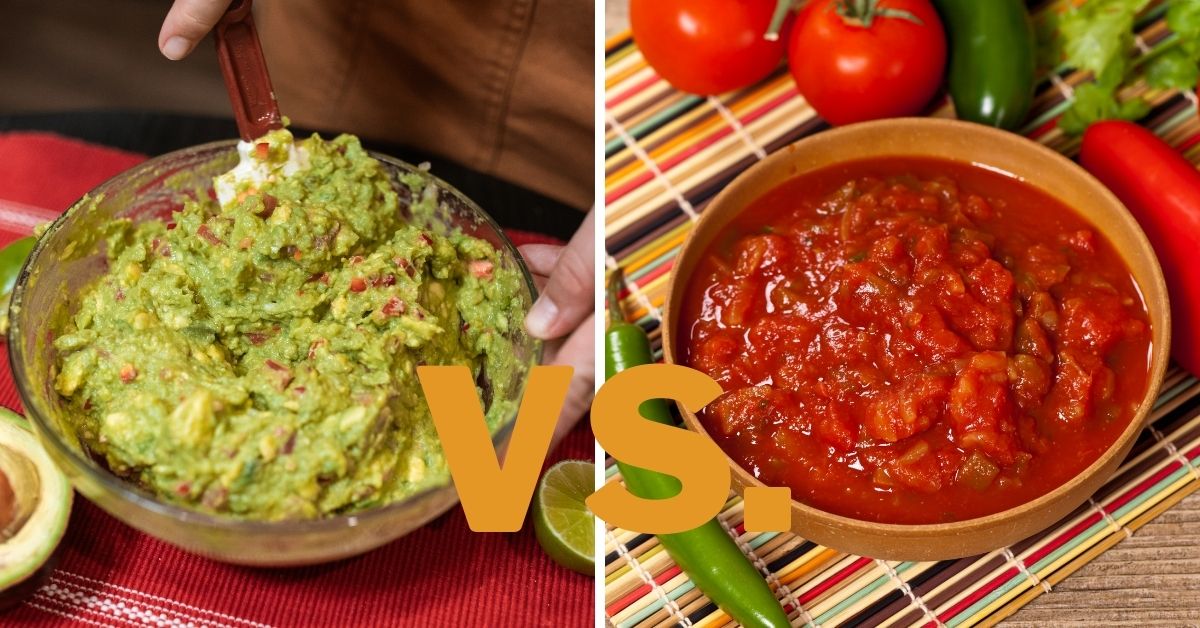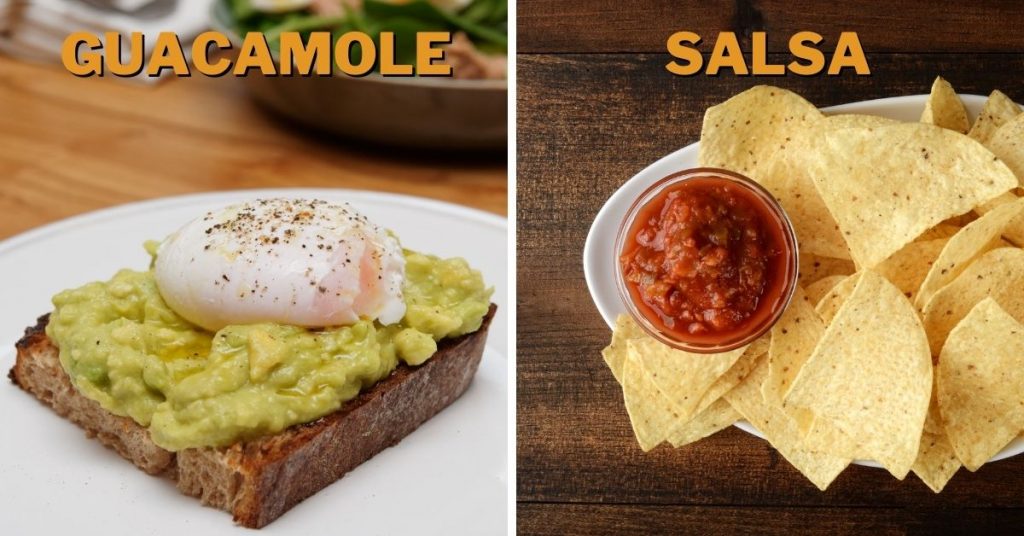Guacamole vs. Salsa: Differences & Which Is Better?

Both guacamole and salsa originated in Mexican cuisine. And they both have similar uses as a dip or as a topping on tacos and enchiladas. And with the popularity of avocado salsa, the two dishes can share a striking resemblance in appearance. But what are their differences? Which one to use, guacamole or salsa?
The key ingredient in guacamole is avocado whereas the main component in salsa is tomato or tomatillo. Many salsa recipes incorporate avocado but they are not essential. Moreover, salsa can be either cooked or raw while guacamole does not involve any cooking or heating.
Both these dishes are a complementary part of various recipes. But they bring different attributes to a dish in taste and appearance. So, in this article, we are going to look at the ways guacamole and salsa differ from one another. Hopefully, this will give you a better idea of how you can utilize them in a particular dish.
Guacamole vs. Salsa: Differences
Etymology
Both salsa and guacamole come from the land of Mexico all the way back during the Aztecs. But the two words indicated two different dishes.
Salsa is basically the Spanish word for sauce. because that is what any salsa dish is; it is a sauce that garnishes other dishes or is used as a dip.
Guacamole is a combination of two words from the ancient Nahuatl language. And those two words refer to avocado and sauce. so, the word guacamole quite literally translates to “avocado sauce” or an avocado-based sauce.
Ingredients
The first important distinction comes in the form of ingredients required. A typical salsa will utilize a variety of tomatoes. Salsa verde will utilize tomatillos, serrano peppers or jalapenos, onions, and some lime juice. But the tomatoes or tomatillos are the main stars of the show.
In comparison, avocados play the primary protagonist’s role in any good guacamole dish. Guacamole literally translates to “avocado sauce”. So, using avocados is what gives this recipe its identity.
Now, you can make salsa that also has avocado. And you can make a guacamole dish that incorporates either fresh tomatoes or tomatillos. But the key ingredient remains unchanged. Guacamole will not be guacamole without avocado and salsa is just not salsa without tomatoes. All other ingredients are more auxiliary than necessities.
Preparation
This is another point of distinction between the two dishes. Typically, guacamole is a fresh sauce made from fresh ingredients. Meaning it does not require any cooking or boiling or even heating. All you need to do is cut the ingredients into small chunks and mash them together until you get a nice consistency.
Salsa, on the other hand, can be served in multiple ways. The term salsa can refer to both cooked and uncooked sauce. Some salsa recipes are similar to guacamole in that they only require you to mix the ingredients. Other variations of salsa will instruct you to cook or fry them in oil before serving on a dish.
In most modern kitchens, salsa is made with the help of a blender. This gives the salsa a lot waterier consistency compared to guacamole.
Taste
Guacamole has a rich and creamy taste with a noticeable tang thanks to the lime juice. It can be more acidic if you add some peppers.
Fresh salsa has a lighter and tangier flavor profile. You can also get a smoky flavor by toasting the tomatoes before pureeing them.
Texture
Guacamole and salsa can have different textures according to how you decide to prepare them. Typically, guacamole is made by mashing all of the ingredients with the help of a potato masher or something similar. This will give the guacamole a consistency similar to mashed potatoes.
Cooked salsa is frequently ground in a blender and then roasted in a pan. Many uncooked salsas are also grounded in a blender and then seasoned before serving. So, the consistency is not quite the same. Salsa has a smoother and lighter texture. In contrast, guacamole is a bit chunkier and thicker.
Of course, you can have a crunchier texture when making both guacamole and salsa. In both instances, you need to cut all of the vegetables into very tiny pieces. Then mix all of the ingredients in a large enough bowl.
Use
For the most part, guacamole and salsa have similar uses, especially if the salsa is made with green tomatoes and avocado. They both can be effectively used as a topping for tacos, dipping tortillas, etc.
Salsa has a lot more variations than guacamole. And salsa can be made with red tomatoes can make your dish pop with color and vibrancy. The homogenous green color of guacamole cannot accomplish that. This is why salsa is a very popular choice for topping enchiladas or tacos.
Guacamole is used for various sandwiches and is often served with eggs.

Nutrition
The nutritional values for guacamole and salsa depend almost entirely on what ingredients you put in. Since, there is a ton of variations when making either of these two dishes, how healthy they can be is up to how healthy you want them to be.
Normally, fresh salsa made with fresh vegetables is a healthy and delicious companion to brunch or dinner. Fresh salsa will probably be lower in fat than guacamole, particularly if you do not add avocado in the salsa. Avocados are relatively high in fat. [1] [2]
So, if you are looking to restrict your calorie and cholesterol levels, then making fresh salsa is a better choice than making guacamole.
Guacamole Vs. Salsa Verde: Difference
On the surface, guacamole and salsa verde look very similar thanks to their similar bright green color. And both dishes can be made with similar ingredients. But there are a few notable differences between the two.
Preparation
As we already discussed, guacamole is exclusively made with avocado. While salsa verde can incorporate avocado in its preparation, it is not a necessity or ever-present.
Salsa verde gets its green color thanks to the use of tomatillos, which is a cousin of the more well-known tomatoes.
So, the main ingredient in salsa verde is tomatillos, which provides the color and much of its freshness. Guacamole achieves its creamy texture from avocados. Avocados tend to be high in fat, which provides guacamole its creaminess.
Both salsa verde and guacamole are prepared without any cooking involved. All of the ingredients are simply mashed or blended together, preserving the freshness of the vegetables.
Taste
Guacamole is a rich and creamy sauce that you can use as a spread or dip. Salsa verde, if it is not made with avocado, is much more acidic and has more heat due to its constant pairing with peppers. Salsa verde also has a more vibrant punch and a lot of freshness to a dish.
Appearance
Both salsa verde and guacamole have a signature green tinge. But you can still tell them apart by noticing some features.
For one thing, salsa verde typically has a runny consistency and resembles closer to a sauce. Guacamole is thicker and resembles more of a paste or cream than sauce.
The color of guacamole can also be lighter than salsa verde. But this depends on the freshness of the ingredients and many other elements. So, it is not the most reliable of indicators to tell them apart all the time.
Guacamole Vs Salsa: Which Is Better?
This comes down to what you are looking for in your dip or spread. Guacamole is better served on top of enchiladas or tacos when you want a very creamy and chunky addition. They are also better if you want a thicker and creamier dip for your fries or bread.
Salsa, on the other hand, can offer more freshness to your dish. You can also freely play around with the texture of salsa, make it chunky or creamy according to your preference. Salsa also adds more color contrast to a dish.
Additionally, if you are on a low-calorie diet, salsa with only fresh vegetables and no avocado is the way to go. By nature, guacamole is going to be a lot higher in fat and calories. Avocados tend to be high in fat, which provides guacamole its creaminess.
To conclude, guacamole and salsa may have their differences but they share one common trait – both are a terrific addition to any tortilla-based and egg-based dishes. And with how flexible both items are, you can add your own twist to make a unique food experience every time.
